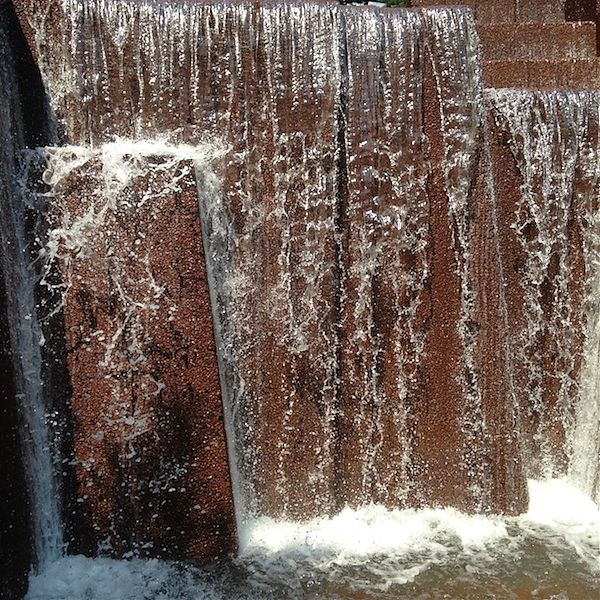Portfolio | Portland Open Space Sequence

The Portland Open Space Sequence, designed by Lawrence Halprin & Associates and build between 1965 and 1978 is a fascinating and entirely relevant interpretation of nature in the city. When I was in Portland last week I took the chance to walk the entire sequence, from the small, pyramidal Source to the crashing, even dangerous cliffs of the Ira Keller Fountain. The Halprin Landscape Conservancy has, slowly but surely, been restoring the four separate parks that make up the sequence; the latest unveiling, which happened in March, was the reconstruction of the copper-clad Lovejoy Fountain Shelter, designed by Halprin in collaboration with Charles Moore and William Turnbull. When I wrote about Moore in May I made a particular point of mentioning Lovejoy. It’s one of several fountains in Moore’s portfolio, and fountains were the subject of his master’s thesis; it suggests a different aesthetic than the pop-classical one usually associated with his work; and it featured a killer anecdote.
“Who threw this tantrum?” That was the reaction—according to Halprin—of a number of Moore’s Yale architectural colleagues when they saw his Lovejoy Fountain Shelter (1966), perched atop the concrete waterfall designed by Moore, Halprin and Turnbull. The whole Portland Open Space Sequence, of which Lovejoy is a part, recalls the natural forms of the nearby High Sierra, with sprays, erosion channels, tumbled rocks, and weirs. Made of a series of board-formed concrete slabs, the fountain works as well with water as without. The pavilion serves as both mountaintop and protection, its expressive hillocks made with a latticework of straight wooden members. One explores the fountain like a natural discovery, climbing down, scaling up, losing one’s sense of oneself in the city. Moore had been interested in water as an element of architecture since his student days; that was, in fact, the topic of his doctoral dissertation at Princeton. In period photographs, one can see the fountain and the shelter against the geometric, repetitive backdrop of nearby SOM towers. “Looking at the photograph of that form, now 50 years old, I thought: This is what people are doing with the computer now,” Lyndon says. “How amazing is the juxtaposition again with the corporate modernism in the background. The latter was the norm of the time.” Before Frank Gehry (with whom Moore and his partners competed for the Beverly Hills Civic Center) lofted an angled chain-link fence in the air at his own famous house, Moore was working with the everyday to make something more monumental, memorable, and strange.



In the historical photograph of Lovejoy in the linked Metropolis article, you can see Lovejoy’s original mountainous backdrop. Today the fountains are indeed surrounded by corporate modernism, both residential towers and glassy offices, which to my mind provide an even greater sense of excitement and escape. You can no longer see the fountains’ inspiration, but instead come upon them like water sources in the urban forest, oases of open space, greenery, waves. I was with my children (as you can see in some of the photos) and they were at first suspicious of my motives for bringing them downtown. I had to keep promising them that fun, both for architecture critics and for kids, was around the corner. At Lovejoy they plunged down the shallow steps into the pool. The lesser-known mounds of Pettygrove Park, next on the list for restoration, pop up like green bubbles. Kids immediately zip up, then down. At Keller, they were initially stunned, bouncing in front of the waterfall on dry land, before they figured out where the pools were, and noticed the narrow shelf where you could walk behind the water.



The interstitial passages between the four elements were as interesting to me. Green canopies, paths lined with high-1970s lampposts, link each fountain to the next, cutting between and across downtown superblocks. The kids thought they could walk without shoes because the passages (for better and for worse) did not feel like the real city. I loved the idea in theory, but in practice the alternate grid may take the fountains too far off the beaten path of the city grid. Along a few of the passages were strange subterranean townhouses. The residents of the towers we saw seemed to be elderly, with dogs: no one moves to Portland now to live in a high rise. The other users of the open spaces were the homeless, who had set up camp under the shelter and on an outcrop of benches at Lovejoy. We were alone there with two sleeping men for a time, until they realized we had invaded their space and moved away. Maintenance workers suggested we not let the kids play in the fountains since they were used every day as baths. Only Keller was busy, mostly with families reverse-commuting to the urban nature.



At Keller, the crashing, symphonic end to the sequence, the particular influence of the Columbia Rover Gorge is obvious. These aren’t just any concrete plates. Their color, their striations, their canted geometric arrangements recreate in miniature the specific landscapes of Oregon. The fountains seem to speak to the continuing yearning of Portland residents not to live in the city at all, naming their companies after natural landmarks, flying into the airport with camping gear on their backs. The open space sequence is like a fissure in a city that has to exist to educate, to produce, to govern, but is always dispersing itself into the countryside. Halprin saw this in the 1960s, and some aspect of that urban personality remains. It’s wonderful that the fountains are being taken care of. I do hope more people can incorporate the plazas and pathways into their daily routines. The idea of an urban playground not just for the kids is very current; there is a lot still to be learned from these examples.
On X
Follow @LangeAlexandraOn Instagram
Featured articles
CityLab
New York Times
New Angle: Voice
Getting Curious with Jonathan Van Ness